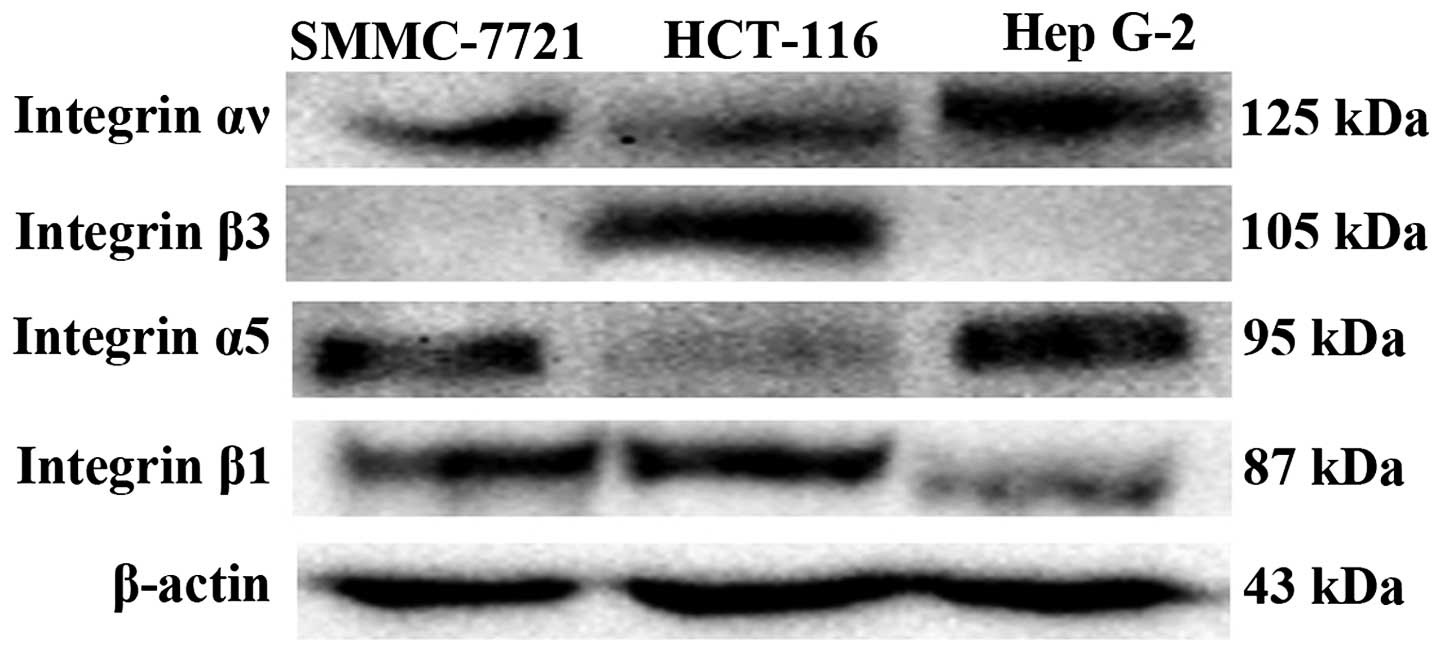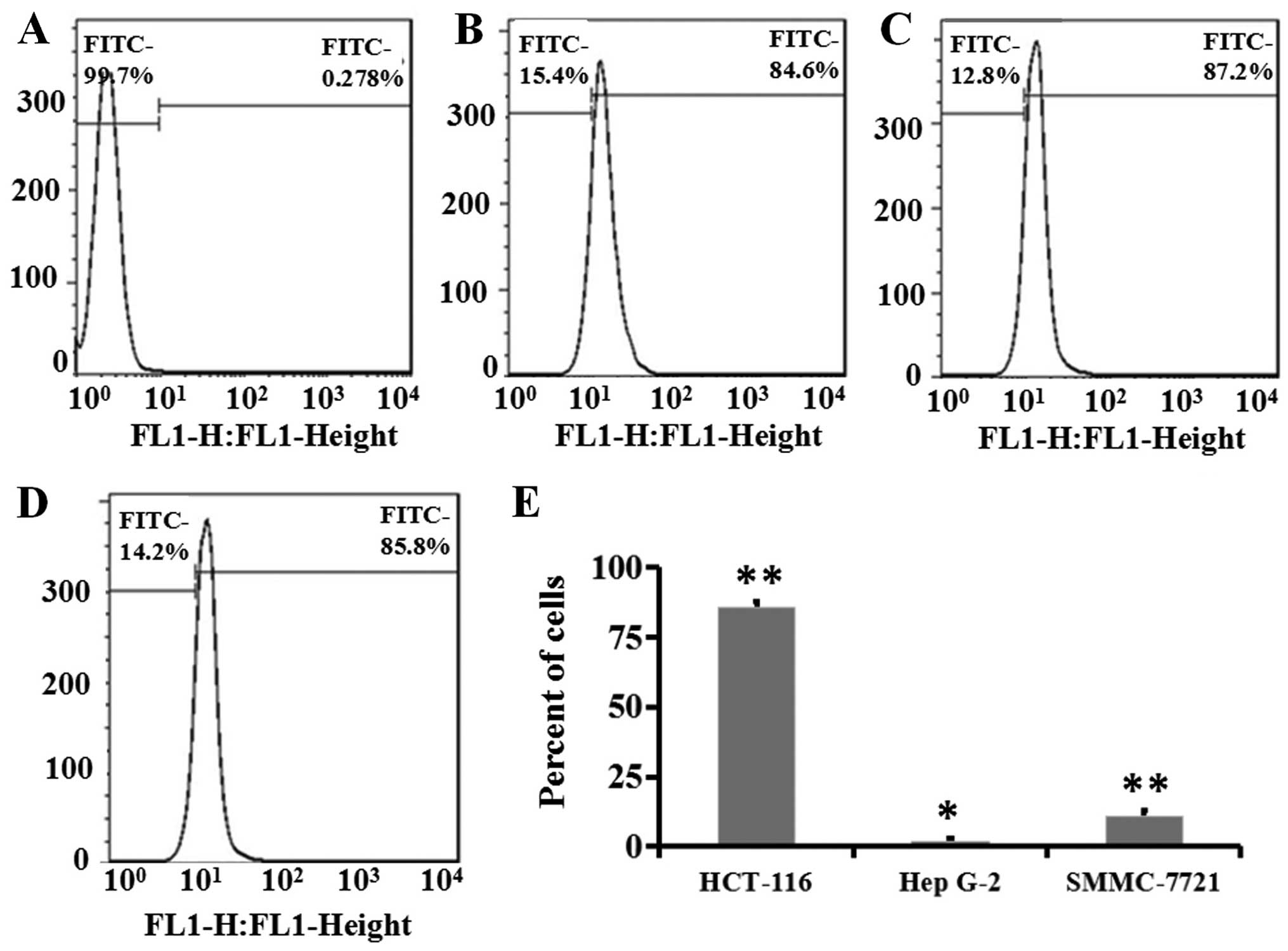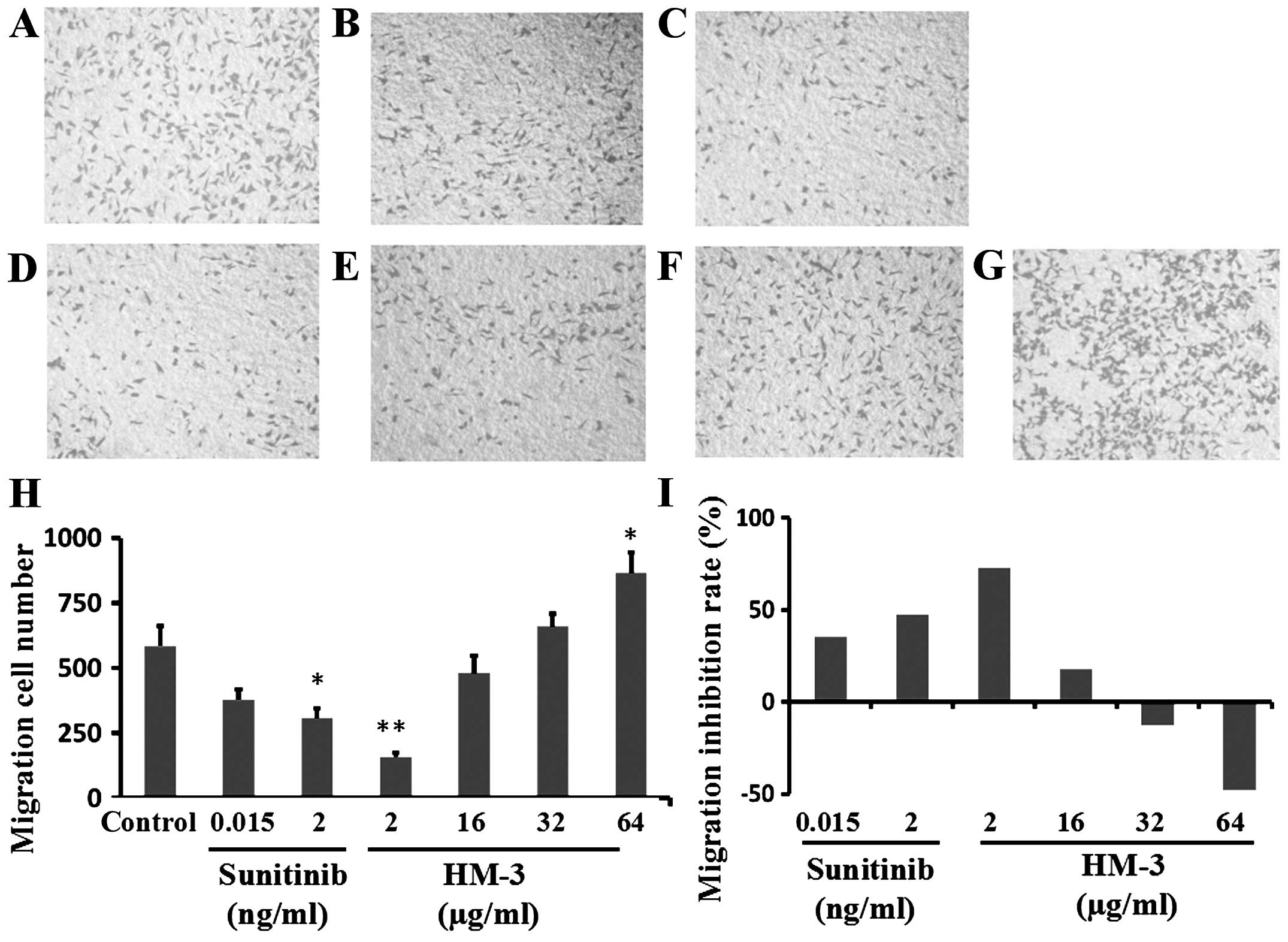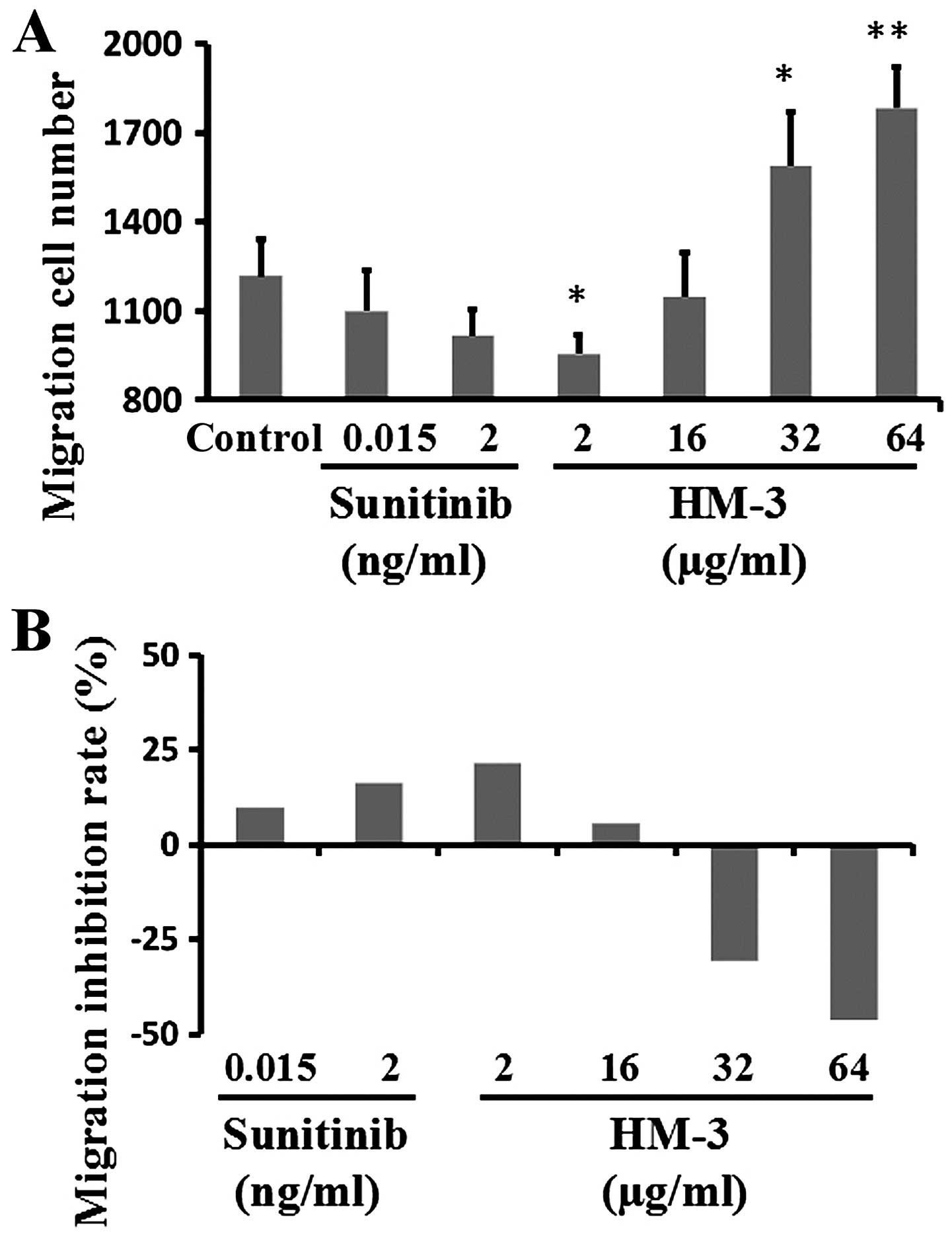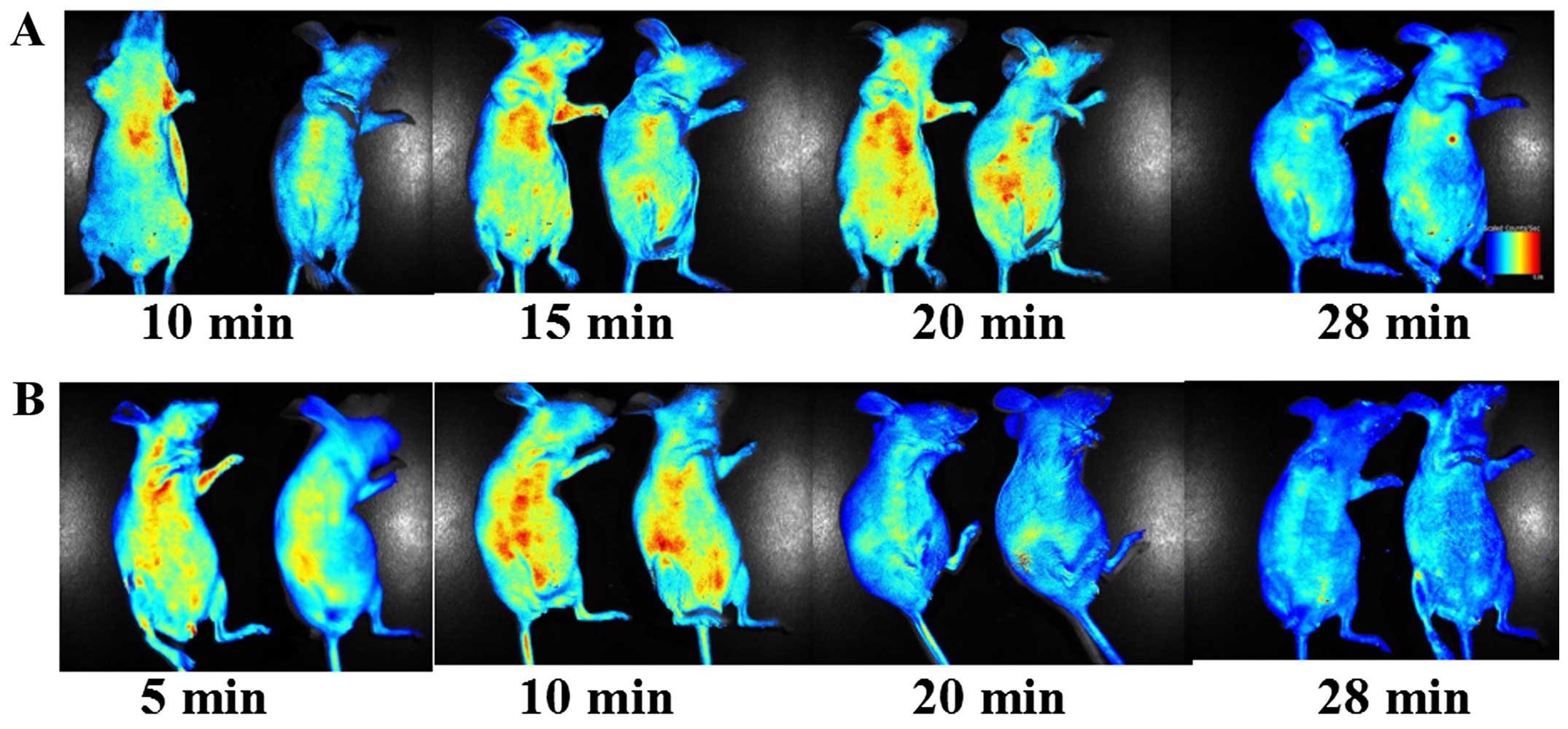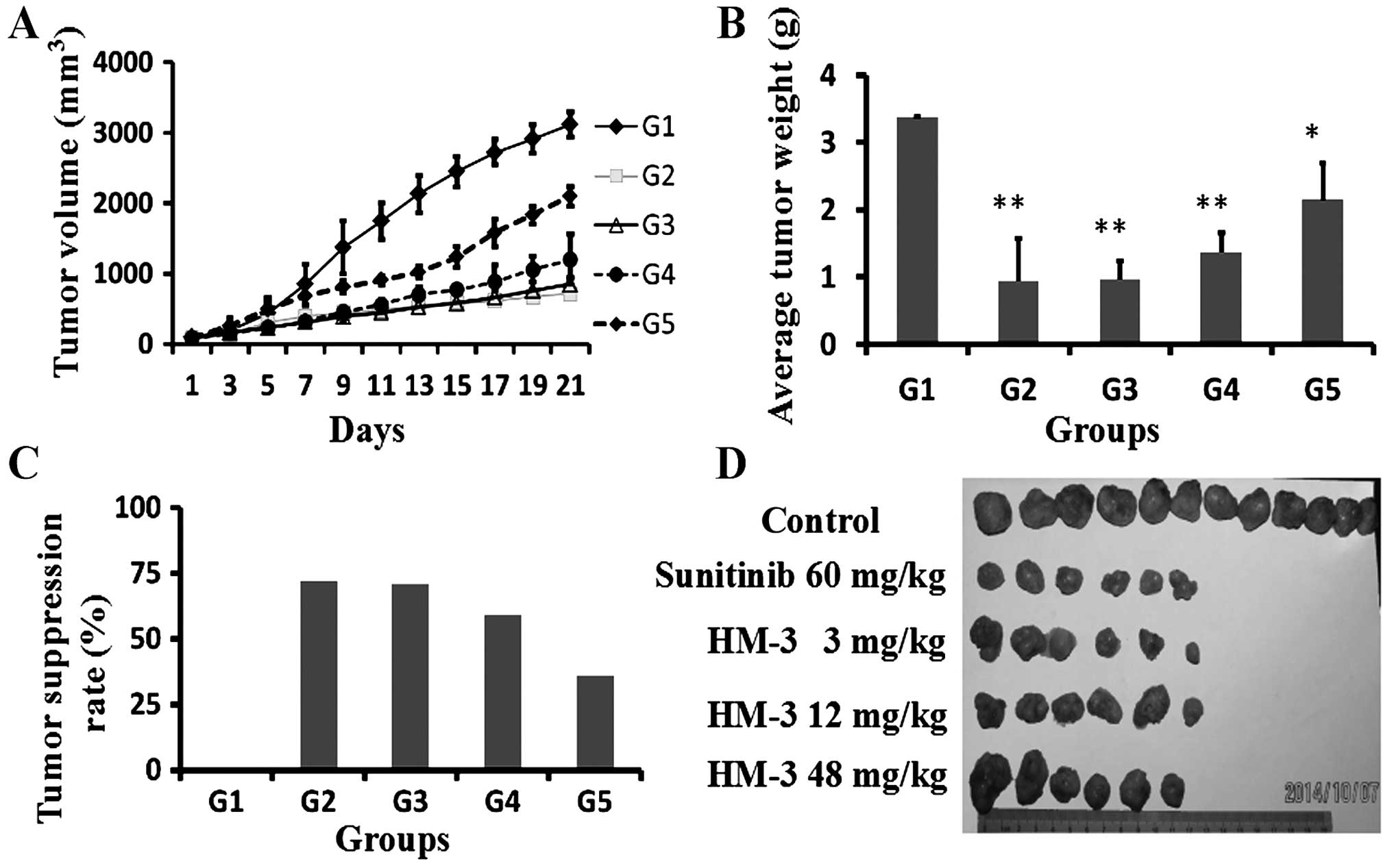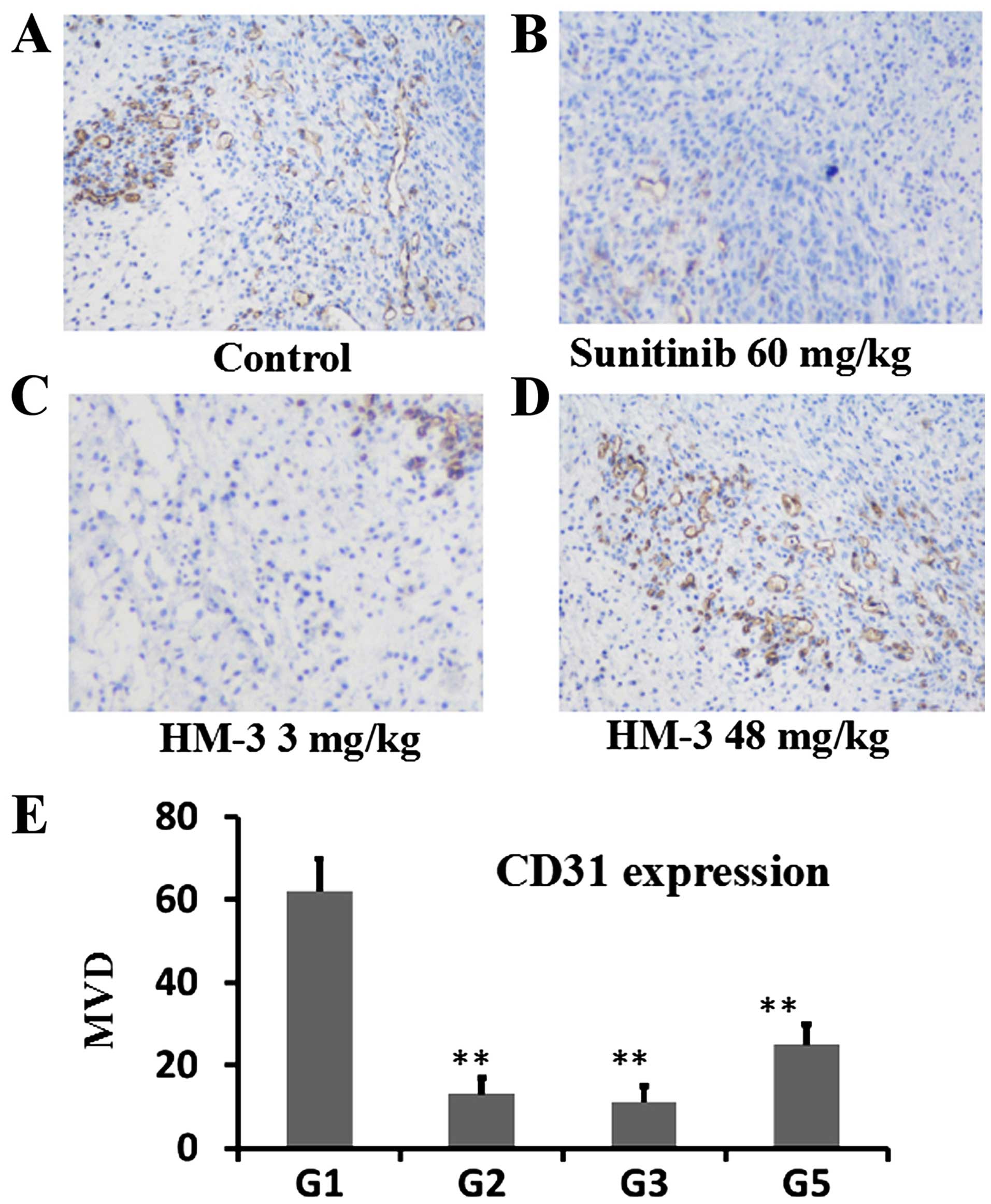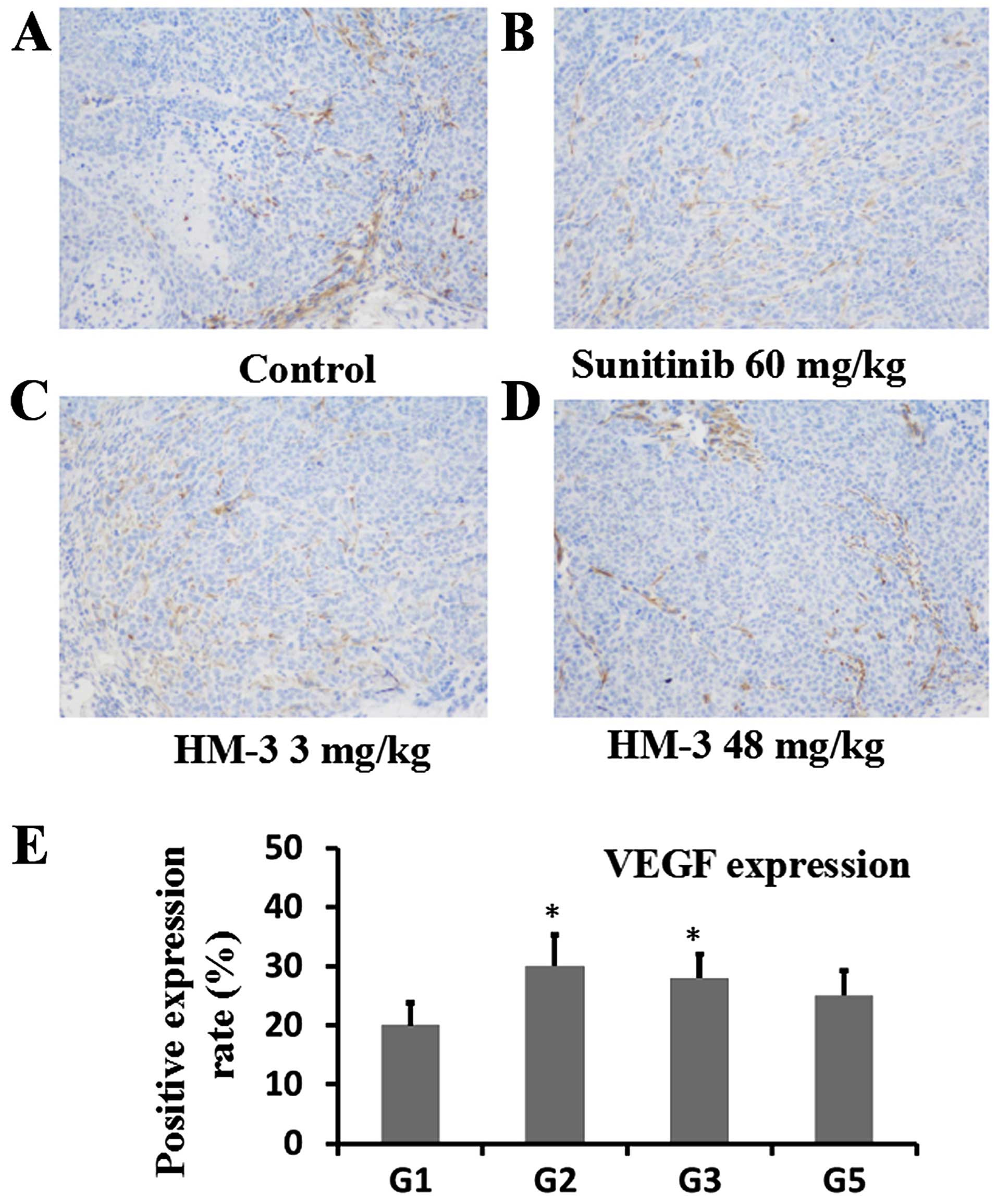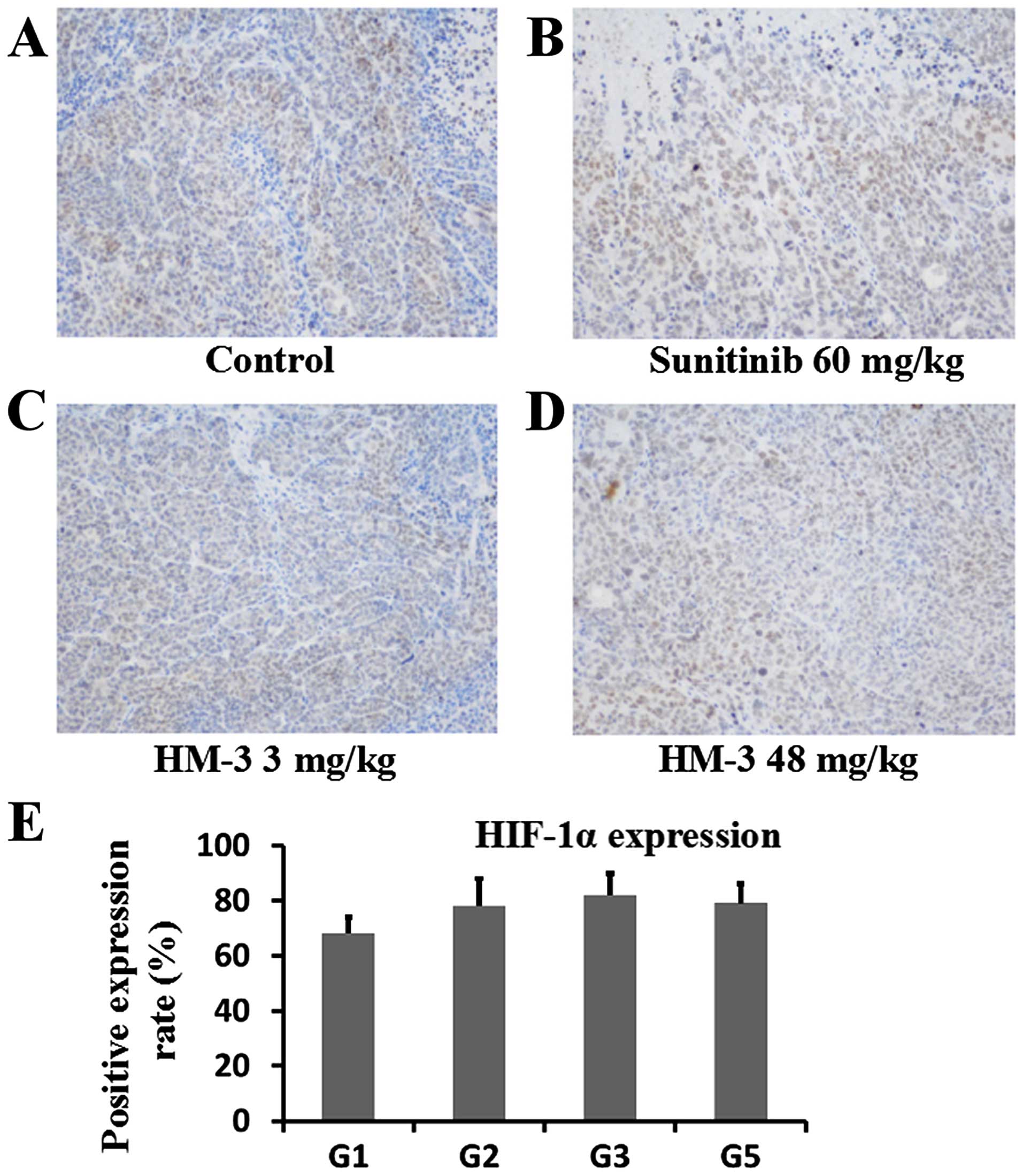|
1
|
Hanahan D and Weinberg RA: Hallmarks of
cancer: The next generation. Cell. 144:646–674. 2011. View Article : Google Scholar : PubMed/NCBI
|
|
2
|
Folkman J: Seminars in Medicine of the
Beth Israel Hospital, Boston. Clinical applications of research on
angiogenesis. N Engl J Med. 333:1757–1763. 1995. View Article : Google Scholar : PubMed/NCBI
|
|
3
|
Sharma RA, Harris AL, Dalgleish AG,
Steward WP and O'Byrne KJ: Angiogenesis as a biomarker and target
in cancer chemoprevention. Lancet Oncol. 2:726–732. 2001.
View Article : Google Scholar
|
|
4
|
Carmeliet P and Jain RK: Angiogenesis in
cancer and other diseases. Nature. 407:249–257. 2000. View Article : Google Scholar : PubMed/NCBI
|
|
5
|
Cai W and Chen X: Anti-angiogenic cancer
therapy based on integrin alphavbeta3 antagonism. Anticancer Agents
Med Chem. 6:407–428. 2006. View Article : Google Scholar : PubMed/NCBI
|
|
6
|
Demetri GD, van Oosterom AT, Garrett CR,
Blackstein ME, Shah MH, Verweij J, McArthur G, Judson IR, Heinrich
MC, Morgan JA, et al: Efficacy and safety of sunitinib in patients
with advanced gastrointestinal stromal tumour after failure of
imatinib: A randomised controlled trial. Lancet. 368:1329–1338.
2006. View Article : Google Scholar : PubMed/NCBI
|
|
7
|
Motzer RJ, Michaelson MD, Redman BG, Hudes
GR, Wilding G, Figlin RA, Ginsberg MS, Kim ST, Baum CM, DePrimo SE,
et al: Activity of SU11248, a multitargeted inhibitor of vascular
endothelial growth factor receptor and platelet-derived growth
factor receptor, in patients with metastatic renal cell carcinoma.
J Clin Oncol. 24:16–24. 2006. View Article : Google Scholar
|
|
8
|
Folkman J: Role of angiogenesis in tumor
growth and metastasis. Semin Oncol. 29(Suppl 16): S15–S18. 2002.
View Article : Google Scholar
|
|
9
|
Brooks PC, Clark RA and Cheresh DA:
Requirement of vascular integrin alpha v beta 3 for angiogenesis.
Science. 264:569–571. 1994. View Article : Google Scholar : PubMed/NCBI
|
|
10
|
Jin H and Varner J: Integrins: Roles in
cancer development and as treatment targets. Br J Cancer.
90:561–565. 2004. View Article : Google Scholar : PubMed/NCBI
|
|
11
|
Kumar CC: Integrin alpha v beta 3 as a
therapeutic target for blocking tumor-induced angiogenesis. Curr
Drug Targets. 4:123–131. 2003. View Article : Google Scholar : PubMed/NCBI
|
|
12
|
Liu Z, Wang F and Chen X: Integrin
alpha(v)beta(3)-targeted cancer therapy. Drug Dev Res. 69:329–339.
2008. View Article : Google Scholar : PubMed/NCBI
|
|
13
|
Meerovitch K, Bergeron F, Leblond L,
Grouix B, Poirier C, Bubenik M, Chan L, Gourdeau H, Bowlin T and
Attardo G: A novel RGD antagonist that targets both alphavbeta3 and
alpha-5beta1 induces apoptosis of angiogenic endothelial cells on
type I collagen. Vascul Pharmacol. 40:77–89. 2003. View Article : Google Scholar : PubMed/NCBI
|
|
14
|
Zhou K, Zheng X, Xu HM, Zhang J, Chen Y,
Xi T and Feng T: Studies of poly(ethylene glycol) modification of
HM-3 polypeptides. Bioconjug Chem. 20:932–936. 2009. View Article : Google Scholar : PubMed/NCBI
|
|
15
|
Xu HM, Yin R, Chen L, Siraj S, Huang X,
Wang M, Fang H and Wang Y: An RGD-modified endostatin-derived
synthetic peptide shows antitumor activity in vivo. Bioconjug Chem.
19:1980–1986. 2008. View Article : Google Scholar : PubMed/NCBI
|
|
16
|
Xu H, Pan L, Ren Y, Yang Y, Huang X and
Liu Z: RGD-modified angiogenesis inhibitor HM-3 dose: Dual function
during cancer treatment. Bioconjug Chem. 22:1386–1393. 2011.
View Article : Google Scholar : PubMed/NCBI
|
|
17
|
Reddy AB, Srivastava SK and Ramana KV:
Aldose reductase inhibition prevents lipopolysaccharide-induced
glucose uptake and glucose transporter 3 expression in RAW264.7
macrophages. Int J Biochem Cell Biol. 42:1039–1045. 2010.
View Article : Google Scholar : PubMed/NCBI
|
|
18
|
Liew K, Yong PV, Lim YM, Navaratnam V and
Ho AS: 2-Methoxy-1,4-Naphthoquinone (MNQ) suppresses the invasion
and migration of a human metastatic breast cancer cell line
(MDA-MB-231). Toxicol In Vitro. 28:335–339. 2014. View Article : Google Scholar
|
|
19
|
Laemmli UK: Cleavage of structural
proteins during the assembly of the head of bacteriophage T4.
Nature. 227:680–685. 1970. View
Article : Google Scholar : PubMed/NCBI
|
|
20
|
Zhao C, Wang X, Zhao Y, Li Z, Lin S, Wei Y
and Yang H: A novel xenograft model in zebrafish for
high-resolution investigating dynamics of neovascularization in
tumors. PLoS One. 6:e217682011. View Article : Google Scholar : PubMed/NCBI
|
|
21
|
Plate KH, Breier G, Millauer B, Ullrich A
and Risau W: Up-regulation of vascular endothelial growth factor
and its cognate receptors in a rat glioma model of tumor
angiogenesis. Cancer Res. 53:5822–5827. 1993.PubMed/NCBI
|
|
22
|
Janouskova H, Ray AM, Noulet F,
Lelong-Rebel I, Choulier L, Schaffner F, Lehmann M, Martin S,
Teisinger J and Dontenwill M: Activation of p53 pathway by
Nutlin-3a inhibits the expression of the therapeutic target α5
integrin in colon cancer cells. Cancer Lett. 336:307–318. 2013.
View Article : Google Scholar : PubMed/NCBI
|
|
23
|
Cheong SJ, Lee CM, Kim EM, Uhm TB, Jeong
HJ, Kim DW, Lim ST and Sohn MH: Evaluation of the therapeutic
efficacy of a VEGFR2-blocking antibody using sodium-iodide
symporter molecular imaging in a tumor xenograft model. Nucl Med
Biol. 38:93–101. 2011. View Article : Google Scholar : PubMed/NCBI
|
|
24
|
Zhang W, Ran S, Sambade M, Huang X and
Thorpe PE: A monoclonal antibody that blocks VEGF binding to VEGFR2
(KDR/Flk-1) inhibits vascular expression of Flk-1 and tumor growth
in an orthotopic human breast cancer model. Angiogenesis. 5:35–44.
2002. View Article : Google Scholar
|
|
25
|
Taherian A, Li X, Liu Y and Haas TA:
Differences in integrin expression and signaling within human
breast cancer cells. BMC Cancer. 11:2932011. View Article : Google Scholar : PubMed/NCBI
|
|
26
|
Senger DR, Perruzzi CA, Streit M,
Koteliansky VE, de Fougerolles AR and Detmar M: The alpha(1)beta(1)
and alpha(2)beta(1) integrins provide critical support for vascular
endothelial growth factor signaling, endothelial cell migration,
and tumor angiogenesis. Am J Pathol. 160:195–204. 2002. View Article : Google Scholar : PubMed/NCBI
|
|
27
|
Szałek E, Karbownik A, Sobańska K, Płotek
W, Grabowski T, Nowak M and Grześkowiak E: The penetration of
sunitinib through the blood-brain barrier after the administration
of ciprofloxacin. Acta Pol Pharm. 71:691–697. 2014.
|
|
28
|
Zhu B, Xu HM, Zhao L, Huang X and Zhang F:
Site-specific modification of anti-angiogenesis peptide HM-3 by
polyethylene glycol molecular weight of 20 kDa. J Biochem.
148:341–347. 2010. View Article : Google Scholar : PubMed/NCBI
|
|
29
|
Pàez-Ribes M, Allen E, Hudock J, Takeda T,
Okuyama H, Viñals F, Inoue M, Bergers G, Hanahan D and Casanovas O:
Antiangiogenic therapy elicits malignant progression of tumors to
increased local invasion and distant metastasis. Cancer Cell.
15:220–231. 2009. View Article : Google Scholar : PubMed/NCBI
|
|
30
|
Loges S, Mazzone M, Hohensinner P and
Carmeliet P: Silencing or fueling metastasis with VEGF inhibitors:
Antiangiogenesis revisited. Cancer Cell. 15:167–170. 2009.
View Article : Google Scholar : PubMed/NCBI
|
|
31
|
Ridley AJ, Schwartz MA, Burridge K, Firtel
RA, Ginsberg MH, Borisy G, Parsons JT and Horwitz AR: Cell
migration: Integrating signals from front to back. Science.
302:1704–1709. 2003. View Article : Google Scholar : PubMed/NCBI
|
|
32
|
Mahabeleshwar GH, Feng W, Reddy K, Plow EF
and Byzova TV: Mechanisms of integrin-vascular endothelial growth
factor receptor cross-activation in angiogenesis. Circ Res.
101:570–580. 2007. View Article : Google Scholar : PubMed/NCBI
|
|
33
|
Mahabeleshwar GH, Feng W, Phillips DR and
Byzova TV: Integrin signaling is critical for pathological
angiogenesis. J Exp Med. 203:2495–2507. 2006. View Article : Google Scholar : PubMed/NCBI
|
|
34
|
Mahabeleshwar GH, Chen J, Feng W, Somanath
PR, Razorenova OV and Byzova TV: Integrin affinity modulation in
angiogenesis. Cell Cycle. 7:335–347. 2008. View Article : Google Scholar : PubMed/NCBI
|
|
35
|
Byzova TV, Kim W, Midura RJ and Plow EF:
Activation of integrin alpha(V)beta(3) regulates cell adhesion and
migration to bone sialoprotein. Exp Cell Res. 254:299–308. 2000.
View Article : Google Scholar : PubMed/NCBI
|
|
36
|
Byzova TV, Goldman CK, Pampori N, Thomas
KA, Bett A, Shattil SJ and Plow EF: A mechanism for modulation of
cellular responses to VEGF: Activation of the integrins. Mol Cell.
6:851–860. 2000.PubMed/NCBI
|
|
37
|
Garrett TA, Van Buul JD and Burridge K:
VEGF-induced Rac1 activation in endothelial cells is regulated by
the guanine nucleotide exchange factor Vav2. Exp Cell Res.
313:3285–3297. 2007. View Article : Google Scholar : PubMed/NCBI
|
|
38
|
Wu J, Strawn TL, Luo M, Wang L, Li R, Ren
M, Xia J, Zhang Z, Ma W, Luo T, et al: Plasminogen activator
inhibitor-1 inhibits angiogenic signaling by uncoupling vascular
endothelial growth factor receptor-2-αVβ3 integrin cross talk.
Arterioscler Thromb Vasc Biol. 35:111–120. 2015. View Article : Google Scholar
|



